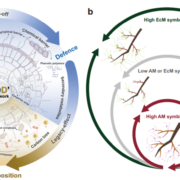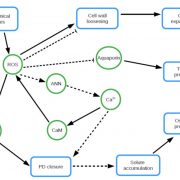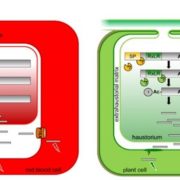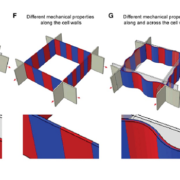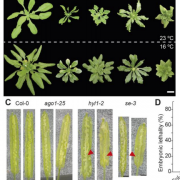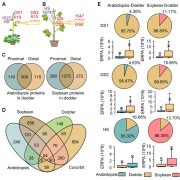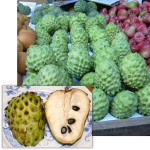How did the daisy get its spots? Gene co-option and fly mimicry
 This is one of those “straight into the textbook” stories. Kellenberger et al. investigated the unusual petal pigmentation pattern of a South African daisy Gorteria diffusa, which has petals with odd lumpy irregular spots that mimic female flies and enhance pollination through sexual deception. The authors undertook an analysis of genes expressed in the spotted parts of the petal versus non-spotted parts, as well as related varieties, to identify the molecular origins of these fly-like spots. Their findings indicate that three groups of genes with other functions in the plant have been co-opted to form these new spots. One group of genes is responsible for the dark pigmentation, and includes genes involved in anthocyanin biosynthesis as well as genes involved in iron homeostasis; binding of iron by anthocyanins darkens the pigments. Another upregulated gene is responsible for the lumpy, possibly fly-like texture and encodes an expansin, a cell-wall loosening protein that is normally expressed in root hairs. The final gene module (SPL1 and a complementary miRNA) controls which petals the spots appear on through shifts in developmental timing. These daisies have several morphotypes which vary in their fly-likeness, providing additional insights into this evolutionary process, which appears to have occured in a modular fashion and rapidly. (Summary by Mary Williams @PlantTeaching) Curr. Biol. 10.1016/j.cub.2023.03.003
This is one of those “straight into the textbook” stories. Kellenberger et al. investigated the unusual petal pigmentation pattern of a South African daisy Gorteria diffusa, which has petals with odd lumpy irregular spots that mimic female flies and enhance pollination through sexual deception. The authors undertook an analysis of genes expressed in the spotted parts of the petal versus non-spotted parts, as well as related varieties, to identify the molecular origins of these fly-like spots. Their findings indicate that three groups of genes with other functions in the plant have been co-opted to form these new spots. One group of genes is responsible for the dark pigmentation, and includes genes involved in anthocyanin biosynthesis as well as genes involved in iron homeostasis; binding of iron by anthocyanins darkens the pigments. Another upregulated gene is responsible for the lumpy, possibly fly-like texture and encodes an expansin, a cell-wall loosening protein that is normally expressed in root hairs. The final gene module (SPL1 and a complementary miRNA) controls which petals the spots appear on through shifts in developmental timing. These daisies have several morphotypes which vary in their fly-likeness, providing additional insights into this evolutionary process, which appears to have occured in a modular fashion and rapidly. (Summary by Mary Williams @PlantTeaching) Curr. Biol. 10.1016/j.cub.2023.03.003


